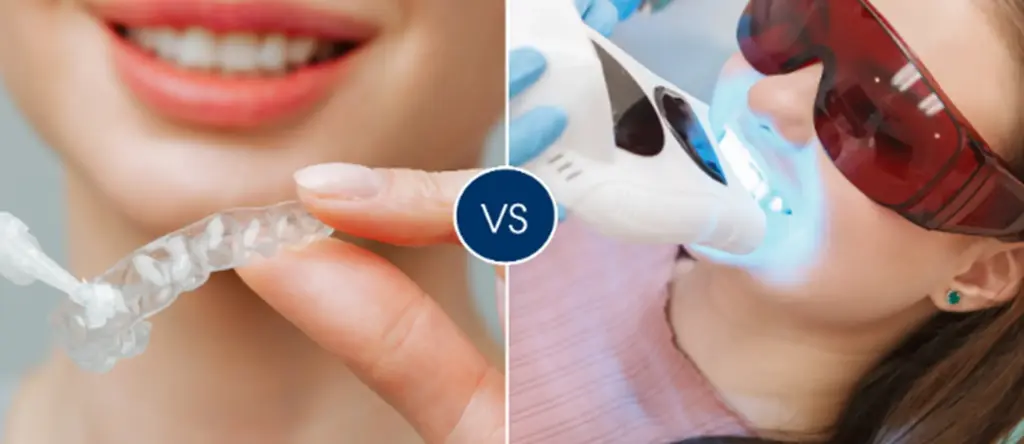Teeth whitening is one of the most popular cosmetic dental treatments today, with many seeking a brighter, more confident smile. But with so many options available, how do you choose between at-home kits and professional treatments? This guide compares both to help you make the right decision based on your lifestyle, goals, and budget.
What Is At-Home Teeth Whitening?

At-home teeth whitening refers to whitening treatments that can be done from the comfort of your home without the supervision of a dentist.
Common At-Home Whitening Products
- Whitening strips: Thin, flexible plastic strips coated with a peroxide-based gel that you place directly on your teeth.
- Teeth whitening pen: A small, portable applicator filled with whitening gel, used to brush directly onto teeth for targeted whitening and quick touch-ups.
- Teeth whitening kits: A set that includes a mouthpiece and LED light used to activate whitening gel and enhance its effectiveness.
- Whitening toothpaste: Contains mild abrasives or low concentrations of peroxide to help remove surface stains over time.
What Is Professional Teeth Whitening at the Dentist?

Professional teeth whitening, also known as in-chair teeth whitening, is a treatment performed at a dental clinic by a licensed professional.
In-Chair Teeth Whitening Procedure
- The treatment is done in a dental clinic under the supervision of a dentist.
- A high-concentration whitening gel is applied to the teeth and may be activated with LED or laser light to speed up the process.
- The entire procedure typically lasts from 45 to 90 minutes, with noticeable results after just one session.
Are Natural Teeth Whitening Methods Effective?
Natural teeth whitening refers to using household ingredients or remedies to brighten teeth without chemical-based products. Common examples include baking soda, activated charcoal, coconut oil pulling, and apple cider vinegar.
While these methods are popular on social media and DIY blogs, their effectiveness is limited, and results are usually minimal. More importantly, some natural ingredients, especially acidic or abrasive substances, can damage tooth enamel when used too often or incorrectly.
At-Home vs Professional Teeth Whitening: Key Differences
| Features | At-Home Whitening | Professional Whitening |
| Convenience | Done anytime at home | Requires a clinic visit |
| Speed | Slower (days to weeks) | Fast (1–2 sessions) |
| Effectiveness | Mild to moderate stain removal | Deep stain removal |
| Safety | Risk of misuse | Supervised by a dentist |
| Customisation | One-size-fits-most | Tailored to individual needs |
Factors to Consider Before Choosing a Whitening Method

Choosing between at-home and dentist teeth whitening depends on a few personal factors:
-
Type of staining:
- Extrinsic stains (surface-level) can often be treated at home.
- Intrinsic stains (deeper discolouration) may require professional whitening.
-
Budget:
- At-home kits are more affordable, while in-clinic whitening comes at a higher cost but offers faster, stronger results.
-
Timeline:
- If you’re preparing for an upcoming event (e.g., wedding, graduation), in-clinic whitening may deliver faster results.
-
Sensitivity concerns:
- If you have sensitive teeth or gums, professional treatments are safer as your dentist can adjust the strength of the whitening agent and monitor the process
Both at-home teeth whitening and in-chair treatments by a dentist can help you achieve a whiter, brighter smile—what matters most is choosing the option that suits your needs, lifestyle, and goals. If you’re looking for convenience and affordability, at-home solutions may be a great fit. But if you want faster, more noticeable results with professional oversight, in-clinic whitening is a worthwhile investment.
Book a teeth whitening consultation with DCA Dental Clinic to receive expert guidance, personalised care, and safe, long-lasting results.
